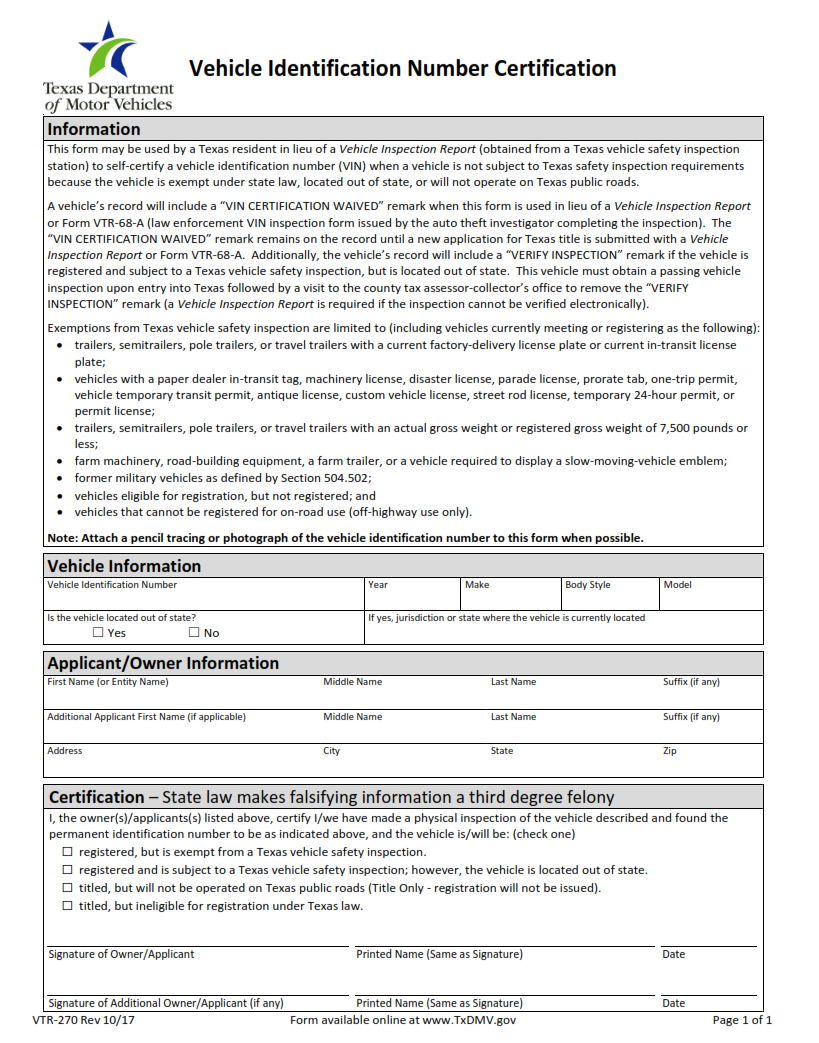ORIGINFORMSTUDIO.COM – VTR-270 – Vehicle Identification Number Certification – Welcome to the comprehensive guide to Vehicle Identification Number (VIN) certification. In this article, we will explore the VTR-270 process and its impact on vehicle owners. Throughout this guide, you’ll learn why VIN certification is necessary, important details on the VTR-270 application process, and other useful information to help you understand what’s involved with certifying your vehicle’s serial number. Whether you’re a car enthusiast or simply looking for information related to a recently purchased vehicle, this guide provides all the essential details surrounding VIN certification.
Download VTR-270 – Vehicle Identification Number Certification
| Form Number | VTR-270 |
| Form Title | Vehicle Identification Number Certification |
| File Size | 1 MB |
| Form By | Texas DMV Form |
What is a VTR-270 Form?
A VTR-270 form is an official document used by the Texas Department of Motor Vehicles (DMV) to certify the Vehicle Identification Number (VIN) of a vehicle. The form must be completed and signed by the registered owner or lienholder in order for the DMV to process a title. The form is used to ensure that all vehicles registered in Texas have properly identified VINs.
The VTR-270 form starts with basic information such as name, address, and contact information of both the vehicle owner and lienholder, if applicable. It also contains questions regarding any changes made to the original VIN plate on the vehicle including its location, whether it has been altered or defaced, or removed from its original place altogether.
What is the Purpose of the VTR-270 Form?
The VTR-270 form is a document used by the Texas Department of Motor Vehicles to verify the accuracy of a vehicle’s Vehicle Identification Number (VIN). This form must be completed and submitted with an application for title and registration, or when transferring ownership of a vehicle.
The purpose of the VTR-270 is to ensure that the information provided on the application for title and registration accurately reflects the physical characteristics of a given vehicle. The form requires certification from either an authorized DMV inspector or someone who has personal knowledge about the specific make, model, year, body type and engine size associated with this particular vehicle. Once certified, these key details are confirmed as accurate on record with the state.
In addition, submitting this form provides evidence that any alterations to original VIN plates have been identified and documented on file.
Where Can I Find a VTR-270 Form?
The VTR-270 form is an important document for vehicle identification in the state of Texas. It is necessary to complete this form in order to register a vehicle or transfer ownership. The form can be found online on the Texas Department of Motor Vehicles website.
The VTR-270 form should be completed completely and accurately in order to ensure that the registration process runs smoothly. The information required includes the make, model, year of manufacture, engine number, and Vehicle Identification Number (VIN) for each vehicle being registered or transferred. This information must match what is printed on the Texas Certificate of Title before submitting to the DMV office or County Tax Office as applicable.
In some cases, a Vehicle Inspection Report (VIR) may also need to be included with your application and must include a valid inspection sticker from an approved inspection station in Texas.
VTR-270 – Vehicle Identification Number Certification
The VTR-270 is an important document for anyone looking to buy, sell or register a vehicle in California. This form is used to verify the Vehicle Identification Number (VIN) of a car and certify that it has been legally registered with the state. The VTR-270 must be completed by the seller, buyer and lien holder before any transfer of ownership can take place.
In order to obtain a VTR-270 form, you must contact your local DMV office or visit their website. The form must include all necessary information about the vehicle such as make and model, year of manufacture, odometer reading and any other relevant details that are required by law. Once this form is completed and signed by both parties involved in the transaction, it should be filed with the Department of Motor Vehicles (DMV).
VTR-270 Form Example
